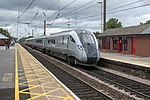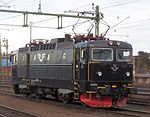Viafèra de Montecara
 | |
| Overview | |
|---|---|
| Owner | State of Montecara |
| Area served | Montecara |
| Transit type | Regional rail, rapid transit, light railway, tram, bus, ferry, bicycle share |
| Number of lines |
|
| Number of stations |
|
| Website | vm.mc |
| Operation | |
| Began operation | 1887 |
| Number of vehicles |
|
| Technical | |
| Track gauge | Meter gauge |
| Electrification | 25 kV / 50 Hz AC Overhead lines |
VM, officially Viafèra de Montecara (Montecaran, Railway of Montecara) and colloquially known as Vimo, is the state railway company and mass transit operator in Montecara. It was created as a public monopoly on 1 December 1941, amalgamating the trams and narrow-gauge steam and electric train lines that crisscrossed the island. It currently operates trains, trams, buses, ferries, and bicycle share.
History
Rail transport in Montecara dates back to 1854, when the city-state’s first railroad was constructed from Porta Nuova to Gabalòn, a distance of 12 km. The line carried cargo and passengers on trains powered by steam-driven locomotives, but was essentially a novelty until a more robust network of rails was developed over the following decades. Longer-distance services were complemented with local tram service beginning in 1867, when a single horse-drawn tram line began operating along Aviènd Zubizarreta. Early rail lines were built and operated as private ventures, most notably by the Conpània Integràl da Viafèra (CIV), a joint-stock corporation that aimed to dominate the domestic railway market.
Payment

All services use a proof of payment model without faregates; there are random ticket inspections aboard transit vehicles.
Tickets are sold at vending machines at train stations and many tram and bus stops, at ticket desks at major stations, at tobacconists' shops, and by mail. Tickets are not sold on board transit vehicles except for buses and trams, on which passengers may buy a single-ride ticket only (exact change in coins required). Tickets must be validated prior to use.
| Ticket | Regular fare |
|---|---|
| Single-ride (90 minutes) | Ł10 |
| Day pass | Ł30 |
| Three-day pass | Ł60 |
| Seven-day pass | Ł120 |
| Monthly pass | Ł400 |
| Annual pass | Ł2400 |
Most residents of Montecara take advantage of the ability to use the Ùnivers card, the national identification card, as a transit pass. The Ùnivers card can be loaded with fares online or at ticket machines located at all rail stations, and inspectors are equipped with scanners that can quickly validate it.
Penalties for riding without a ticket vary from as low as Ł300 and ejection at the next stop for a first offense, to Ł1000 or more for repeat offenses. Penalties are administered and collected by VM and do not fall under criminal law. Traveling with an invalid ticket type, such as a reduced-fare ticket when ineligible for one, is treated the same as traveling without a ticket.
Reduced-fare tickets are half the regular price. They are available to passengers aged 62 or over, students, the disabled, and those receiving state aid. Reduced-fare tickets are sold at all ticket vending locations. It is up to the passenger to prove eligibility by carrying valid identification.
Services
Intercity rail
The longest-distance services that VM offers are branded as VM Intercità and connect Montecara with destinations in Florena and Etruria that are outside the range of transit or regional rail.
Regional rail
Services that connect Montecara with relatively close points in Florena are branded as VM Rexiò. Trains generally stop at all stations and run at frequent and regular intervals throughout the day.
Transit rail

VM operates three distinct types of rail transit: heavy-rail rapid transit lines that are grade-separated and have high running speeds and limited stops; light rail lines that are partially grade-separated and have moderate speeds and capacities; and a legacy tram network that runs in mixed traffic and provides curbside service along its entire route.
Rapid transit and light rail routes are collectively branded as Metrovìa. These are designed to move passengers quickly between districts within the urban area of Montecara and between the center city and outlying areas. Stations are generally spaced between 500 and 1500 meters apart, equivalent to a 5 to 15-minute walk.
The tram network, branded as Tranvìa, operates smaller, older trams that are capable of climbing steep hills and navigating tight corners. These routes have been left in place because there is no viable modern alternative mode that is capable of serving their routes, which means that withdrawing service would leave residents of these areas with no access to any form of transit. Indeed, in many of these areas, they are the only means of wheeled transport aside from bicycles. Trams run daily from at least 6:00 to 23:00, though they may run less frequently during off-peak hours, weekends, and public holidays.
Bus
VM operates two types of bus service: Autobùs, a typical transit bus service, and Corièra, which provides longer-distance limited-stop services between the urban center of Montecara and outlying communes, particularly those not well-served by rail.
Autobùs vehicles have all been low-floor since 2009. Certain crowded areas have dedicated lanes and signal priority that allow buses to maintain a relatively high speed compared to other traffic. VM is in the process of converting its entire Autobùs fleet to electric buses, with the goal of having a 100% electric fleet by 2022.
Corièra coaches are equipped with larger, more comfortable seats as well as a toilet and, in newer models, power outlets at every seat.
Ferry
VM's ferry service is branded as Vaporèt. The Montecaran state took over a number of unprofitable ferry lines in 1890, turning them into a single public marine transit company that would later become part of VM. The service currently operates routes across the Bay of Montecara, connecting areas that do not have direct links via bridges or tunnels.
The bicycle share system, Metrobìci, debuted in 2006.
Rolling stock
| Image | Type | Class | Services | Max. speed | Notes |
|---|---|---|---|---|---|

|
Electric multiple unit | 802 | Exprima | 225 km/h | Entered service 2018. |

|
Electric multiple unit | X55 | Exprima | 200 km/h | Entered service 2000–2013. |

|
Electric locomotive | X2 | Exprima, Direta | 200 km/h | Entered service 1989–1998. Refurbished 2003–2007 and 2018–2020. |

|
Electric multiple unit | X40 | Rexio | 200 km/h | Double-deck coaches. Entered service 2006–2019. |

|
Electric locomotive | Rc | Rexio | 160 km/h | Entered service 1967–1988. |

